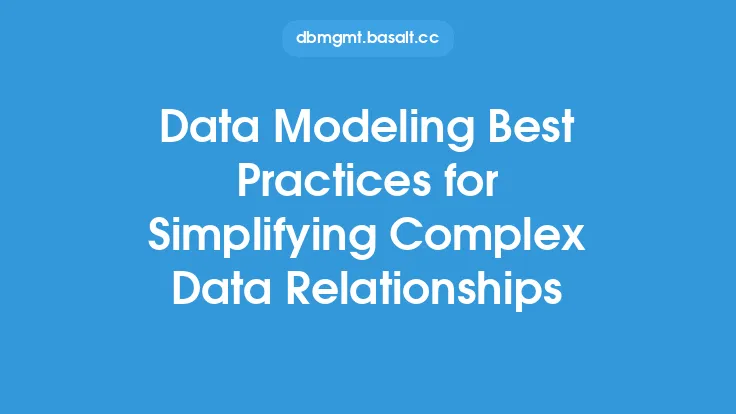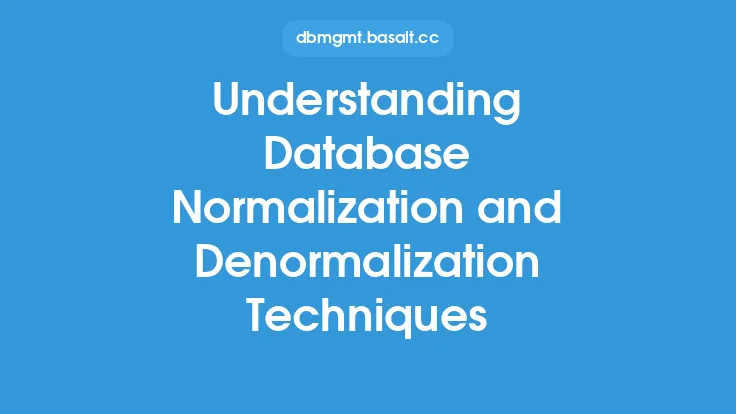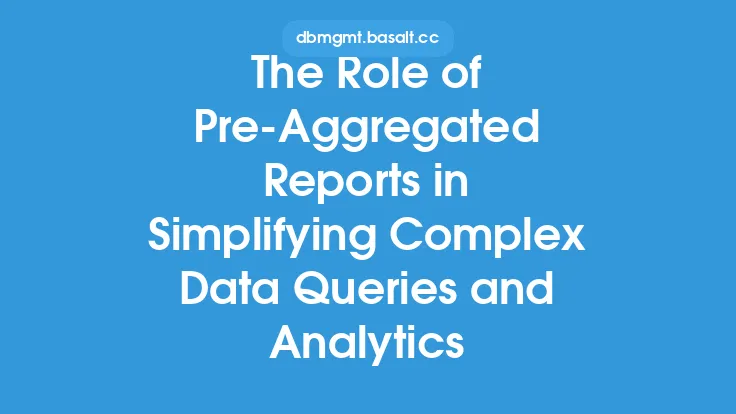When dealing with complex database queries, one of the most effective techniques for simplifying and optimizing them is denormalization. Denormalization involves intentionally deviating from the principles of normalization, which aim to minimize data redundancy and dependency, to improve the performance of certain queries. In this article, we will delve into the world of denormalization techniques, exploring how they can be used to simplify complex database queries and improve overall database performance.
Introduction to Denormalization
Denormalization is a database design technique that involves storing data in a way that is not fully normalized. Normalization is the process of organizing data in a database to minimize data redundancy and dependency. While normalization is essential for maintaining data consistency and reducing data anomalies, it can sometimes lead to complex queries that are slow to execute. Denormalization, on the other hand, involves storing data in a way that is optimized for query performance, even if it means introducing some data redundancy.
Types of Denormalization
There are several types of denormalization techniques, each with its own strengths and weaknesses. Some of the most common types of denormalization include:
- Pre-aggregation: This involves pre-calculating and storing aggregate values, such as sums or averages, to avoid having to calculate them on the fly.
- Pre-joining: This involves storing data from multiple tables in a single table, to avoid having to join them together at query time.
- Data duplication: This involves storing duplicate copies of data, to avoid having to retrieve it from multiple locations.
- Summary tables: This involves creating summary tables that contain aggregated data, to avoid having to query the underlying data.
Denormalization Techniques for Simplifying Complex Queries
Denormalization can be used to simplify complex queries in a number of ways. For example:
- By pre-aggregating data, denormalization can reduce the amount of calculation required to answer a query, making it faster and more efficient.
- By pre-joining data, denormalization can reduce the number of joins required to answer a query, making it faster and more efficient.
- By duplicating data, denormalization can reduce the number of queries required to retrieve data, making it faster and more efficient.
- By creating summary tables, denormalization can provide a simplified view of complex data, making it easier to query and analyze.
Implementing Denormalization
Implementing denormalization requires careful consideration of the trade-offs involved. On the one hand, denormalization can improve query performance and simplify complex queries. On the other hand, it can introduce data redundancy and inconsistency, which can be difficult to manage. To implement denormalization effectively, database designers must carefully evaluate the needs of their application and determine where denormalization can be used to improve performance.
Best Practices for Denormalization
To get the most out of denormalization, database designers should follow some best practices. These include:
- Only denormalize data that is frequently accessed or queried.
- Use denormalization to simplify complex queries, rather than to improve data storage or retrieval.
- Carefully evaluate the trade-offs involved in denormalization, and consider the potential impact on data consistency and integrity.
- Use indexing and other query optimization techniques to improve the performance of denormalized data.
- Regularly review and maintain denormalized data to ensure that it remains consistent and up-to-date.
Common Use Cases for Denormalization
Denormalization is commonly used in a number of scenarios, including:
- Data warehousing: Denormalization is often used in data warehousing to improve the performance of complex queries and to provide a simplified view of large datasets.
- Real-time analytics: Denormalization is often used in real-time analytics to improve the performance of queries and to provide fast and accurate results.
- Big data: Denormalization is often used in big data applications to improve the performance of queries and to provide a simplified view of large and complex datasets.
- High-traffic web applications: Denormalization is often used in high-traffic web applications to improve the performance of queries and to provide fast and accurate results.
Tools and Technologies for Denormalization
There are a number of tools and technologies available to support denormalization, including:
- Database management systems: Most database management systems, including relational databases and NoSQL databases, support denormalization.
- Data warehousing tools: Data warehousing tools, such as Amazon Redshift and Google BigQuery, provide built-in support for denormalization.
- ETL tools: ETL (Extract, Transform, Load) tools, such as Informatica and Talend, provide support for denormalization as part of the data integration process.
- Data modeling tools: Data modeling tools, such as Entity-Relationship diagrams and data flow diagrams, can be used to design and implement denormalized databases.
Conclusion
Denormalization is a powerful technique for simplifying complex database queries and improving overall database performance. By intentionally deviating from the principles of normalization, database designers can create databases that are optimized for query performance, even if it means introducing some data redundancy. While denormalization requires careful consideration of the trade-offs involved, it can be a highly effective way to improve the performance of complex queries and to provide fast and accurate results. By following best practices and using the right tools and technologies, database designers can get the most out of denormalization and create databases that are fast, efficient, and scalable.





